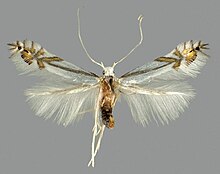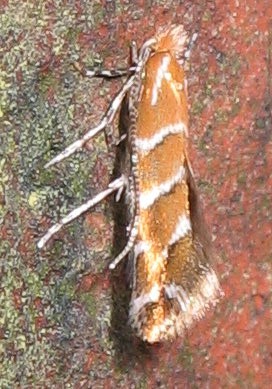
The horse-chestnut leaf miner is a leaf-mining moth of the family Gracillariidae. The horse-chestnut leaf miner was first observed in North Macedonia in 1984, and was described as a new species in 1986. Its larvae are leaf miners on the common horse-chestnut. The horse-chestnut leafminer was first collected and inadvertently pressed in herbarium sheets by the botanist Theodor von Heldreich in central Greece in 1879.

Phyllanthus is the largest genus in the plant family Phyllanthaceae. Estimates of the number of species in this genus vary widely, from 750 to 1200. Phyllanthus has a remarkable diversity of growth forms including annual and perennial herbs, shrubs, climbers, floating aquatics, and pachycaulous succulents. Some have flattened leaflike stems called cladodes. It has a wide variety of floral morphologies and chromosome numbers and has one of the widest range of pollen types of any seed plant genus.

Gracillariidae is an important family of insects in the order Lepidoptera and the principal family of leaf miners that includes several economic, horticultural or recently invasive pest species such as the horse-chestnut leaf miner, Cameraria ohridella.

Phyllocnistis drimiphaga is a moth of the family Gracillariidae. It is known only from cloud forests above 2000 m in Cordillera de Talamanca and Central Conservation Area in Costa Rica.
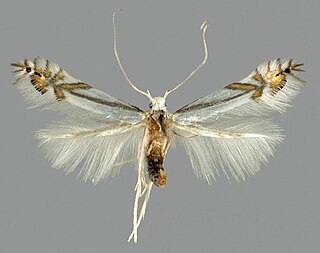
Phyllocnistis tropaeolicola is a moth of the family Gracillariidae. It is known only from Cerro de la Muerte, Villa Mills, at 3,100 m elevation in the Cordillera de Talamanca in Costa Rica.

Epicephala is a genus of moths in the family Gracillariidae.
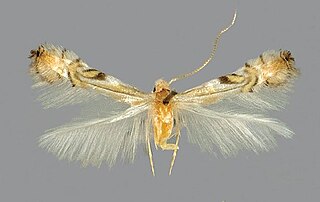
Phyllocnistis is a genus of moths in the family Gracillariidae.
Caloptilia prosticta is a moth of the family Gracillariidae. It is known from Madagascar, Nigeria, the Seychelles, South Africa and Sri Lanka.
Phyllocnistis puyehuensis is a moth of the family Gracillariidae, known from Chile. It was named by D.R. Davis in 1994.
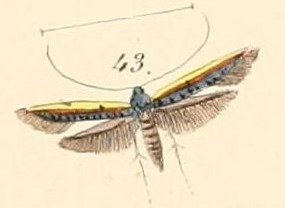
Caloptilia chrysitis is a moth of the family Gracillariidae. It is endemic to New Zealand. The larvae of this species mine and fold the leaves of species in the genera Weinmannia andElaeocarpus as well as Knightia excelsa, although only rarely for the later species.
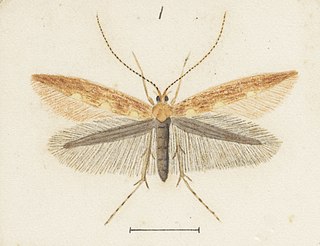
Caloptilia elaeas is a moth of the family Gracillariidae. It is known from New Zealand.

Caloptilia selenitis is a moth of the family Gracillariidae. It is known from New Zealand.
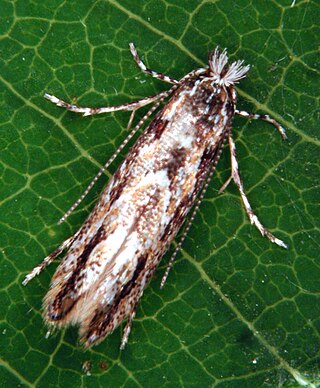
Lithocolletinae is a subfamily of insects in the moth family Gracillariidae. It is distributed worldwide, with most species in temperate regions.

Gracillariinae are a subfamily of moths which was described by Henry Tibbats Stainton in 1854.

Uromycladium tepperianum is a rust fungus that infects over 100 species of Acacia and related genera including Paraserianthes in Australia, south-east Asia, the south Pacific and New Zealand. The acacia gall rust fungus species Uromycladium tepperianum has been introduced to South Africa as a biological control on the invasive Australian shrub Acacia saligna.

Acrocercopinae is a subfamily of moths described by Akito Yuji Kawahara and Issei Ohshima in 2016.

Ornixolinae is a subfamily of moths described by Vladimir Ivanovitsch Kuznetzov and Svetlana Vladimirovna Baryshnikova in 2001.

Marmarinae is a subfamily of moths described by Akito Yuji Kawahara and Issei Ohshima in 2016.

Parornichinae is a subfamily of moths described by Vladimir Ivanovitsch Kuznetzov and Svetlana Vladimirovna Baryshnikova in 2001.
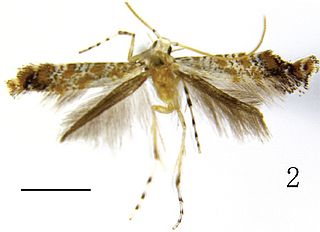
Oecophyllembiinae is a subfamily of moths described by Pierre Réal and Alfred Serge Balachowsky in 1966.
